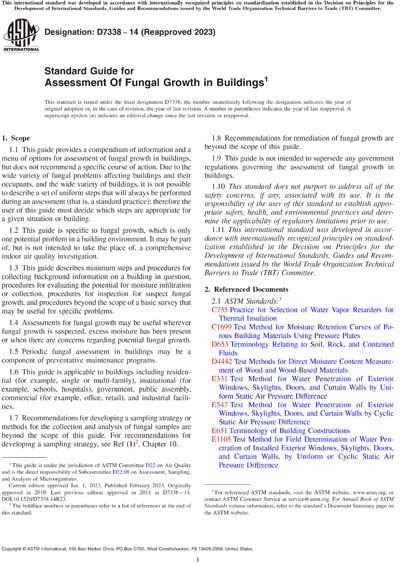Most recent
ASTM D7338-14(2023)
Standard Guide for Assessment Of Fungal Growth in Buildings
1.1This guide provides a compendium of information and a menu of options for assessment of fungal growth in buildings, but does not recommend a specific course of action. Due to the wide variety of fungal problems affecting buildings and their occupants, and the wide variety of buildings, it is not possible to describe a set of uniform steps that will always be performed during an assessment (that is, a standard practice); therefore the user of this guide must decide which steps are appropriate for a given situation or building.
1.2This guide is specific to fungal growth, which is only one potential problem in a building environment. It may be part of, but is not intended to take the place of, a comprehensive indoor air quality investigation.
1.3This guide describes minimum steps and procedures for collecting background information on a building in question, procedures for evaluating the potential for moisture infiltration or collection, procedures for inspection for suspect fungal growth, and procedures beyond the scope of a basic survey that may be useful for specific problems.
1.4Assessments for fungal growth may be useful wherever fungal growth is suspected, excess moisture has been present or when there are concerns regarding potential fungal growth.
1.5Periodic fungal assessment in buildings may be a component of preventative maintenance programs.
1.6This guide is applicable to buildings including residential (for example, single or multi-family), institutional (for example, schools, hospitals), government, public assembly, commercial (for example, office, retail), and industrial facilities.
1.7Recommendations for developing a sampling strategy or methods for the collection and analysis of fungal samples are beyond the scope of this guide. For recommendations for developing a sampling strategy, see Ref (1)2, Chapter 10.
1.8Recommendations for remediation of fungal growth are beyond the scope of this guide.
1.9This guide is not intended to supersede any government regulations governing the assessment of fungal growth in buildings.
1.10This standard does not purport to address all of the safety concerns, if any, associated with its use. It is the responsibility of the user of this standard to establish appropriate safety, health, and environmental practices and determine the applicability of regulatory limitations prior to use.
1.11This international standard was developed in accordance with internationally recognized principles on standardization established in the Decision on Principles for the Development of International Standards, Guides and Recommendations issued by the World Trade Organization Technical Barriers to Trade (TBT) Committee.
ASTM International [astm]

